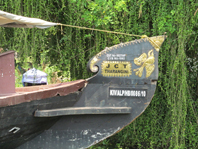David Stairs
“May in Ayemenem is a hot, brooding month. The days are long and humid. The river shrinks and black crows gorge on bright mangoes in still, dustgreen trees. Red bananas ripen. Jackfruits burst. Dissolute bluebottles hum vacuously in the fruity air. Then they stun themselves against clear windowpanes and die, fatly baffled in the sun. The nights are clear but suffused with sloth and sullen expectation.” —Arundhati Roy, The God of Small Things

The signature National Geographic tourist experience of a visit to Kerala is a trip into its famous backwaters. This system of canals, estuaries, and irrigation ditches, part natural, part man-made, honeycomb the Keralan coast from Kodangallor in the north to Alleppey in the south, a distance of over 50 kilometers. This is Arundhati Roy country.

Rope dyers
Centered on Lake Vembanad, the largest fresh water lake in Kerala, the Indian government constructed an elaborate series of canals and dikes to control flooding and irrigation. Local people literally live atop these dikes and use them as an alternate means of transportation, alternate to the waters themselves.

From atop and beside these walls people fish, bathe, and do laundry. Children run and ride bikes. People sit in the shade and work. Behind are the paddies and fields, two meters below sea level, and flooded every year by the monsoon. Occasionally, about every fifth year I was told, excessive rainfall floods villagers out, forcing them into government-provided lodgings until the waters subside.


Our own 60 kilometer round-trip float through central Kerala began at a boatyard where L&S tours has a staging office in a moored houseboat. The steel keels of future boats rest in various stages of construction all around us. Nearby sits a wooden keel. Formerly, houseboats were made of wood, but current practice builds a ribbed steel skeleton and skins it with steel plates. Wooden stem and stern end curls are added atop this, and a deck, then the cabins are framed and infrastructure added.


Because tourism is a major industry in Kerala, houseboats cater to many foreign as well as Indian tourists. They are lavishly outfitted with all the comforts of home, including a shower. Originally, houseboats were poled, and a few still are, but they are a vanishing breed. Nowadays, boats are equipped with powerful diesel engines, generators, 24-volt battery packs, and even solar panels, the better to handle electric lights, air-conditioning, and even a cable TV hook-up that awaits at the evening’s mooring place if you just can’t break your media addiction.

Houseboats come in many sizes to suit a variety of needs. We were in a single stateroom boat; the crew slept outdoors on the upper deck. But we saw two-, three-room, and even larger boats on the water, some looking like floating casinos. These likely are used for group day trips and parties, as opposed to the honeymoon getaway smaller boats.

Houseboat exteriors are finished with an elaborate covering of mats anchored in place with bamboo strips and braided coir. Windows are surrounded by small, rope framed gables that protrude slightly, creating a rain barrier.


Our boat had a two-man crew, Kunju the steadfast pilot, and Asokan the masterful cook. Kunju has been working on boats for a decade. He told us that at high season, usually sometime in January, as many as 1,000 houseboats ply the backwaters of Kerala. I never counted more than 24 at any given time, and these represented a steady stream of traffic. This huge volume of commercial traffic, and it’s growing every year, has an adverse effect on the environment. Our boat carried a sign stating that it was outfitted with a bio-treatment system, a reassuring indication that raw sewage was being properly handled.

There are a number of other boat types on the water. Single-man canoes ply the banks looking for people who need to jump across to the opposite bank. Large two-man commercial canoes with outrigger engines and attached propellers stream noisily past in both directions. By far the busiest vehicle on the water is the ferry bus, a low-slung 50 passenger sloop with powerful engines that swoops in for a quick drop, and just as hastily reverses course and heads off to its next stop.


Ferry taxi left, two-man canoe right
Except for the stuffy cabin, the houseboat trip was a very peaceful escape from everyday cares. The sights and sounds were relaxing, and the overall landscape breathtaking, not to mention the air quality being a welcome relief from the city. It made me realize that some of earth’s residents are fortunate enough to live in remote splendor, and that’s an enviable fate.

David Stairs is the founding editor of Design-Altruism-Project











Leave a Reply
You must be logged in to post a comment.